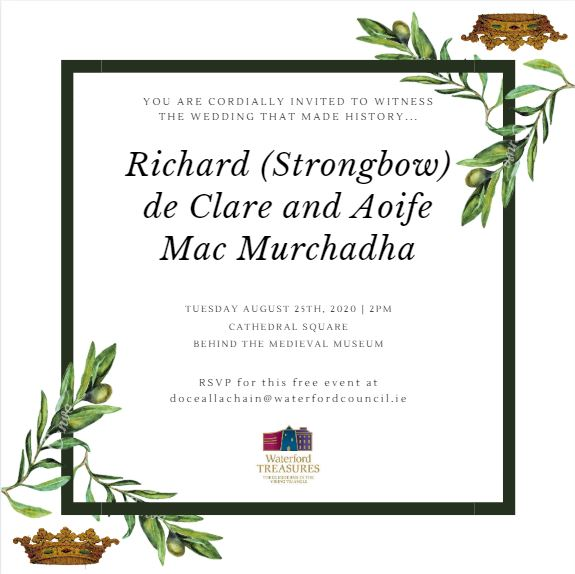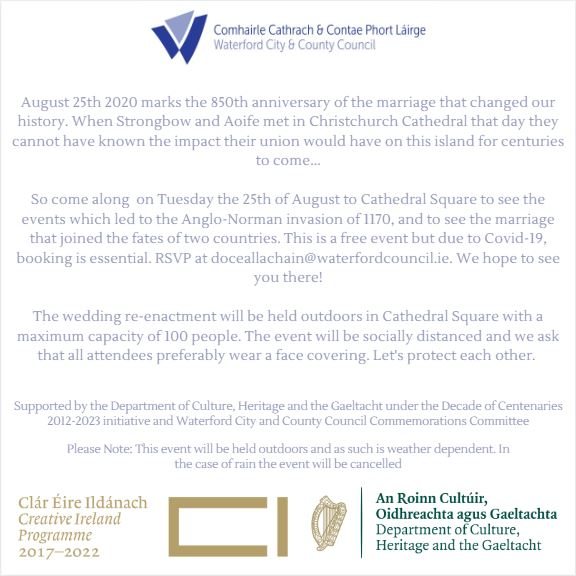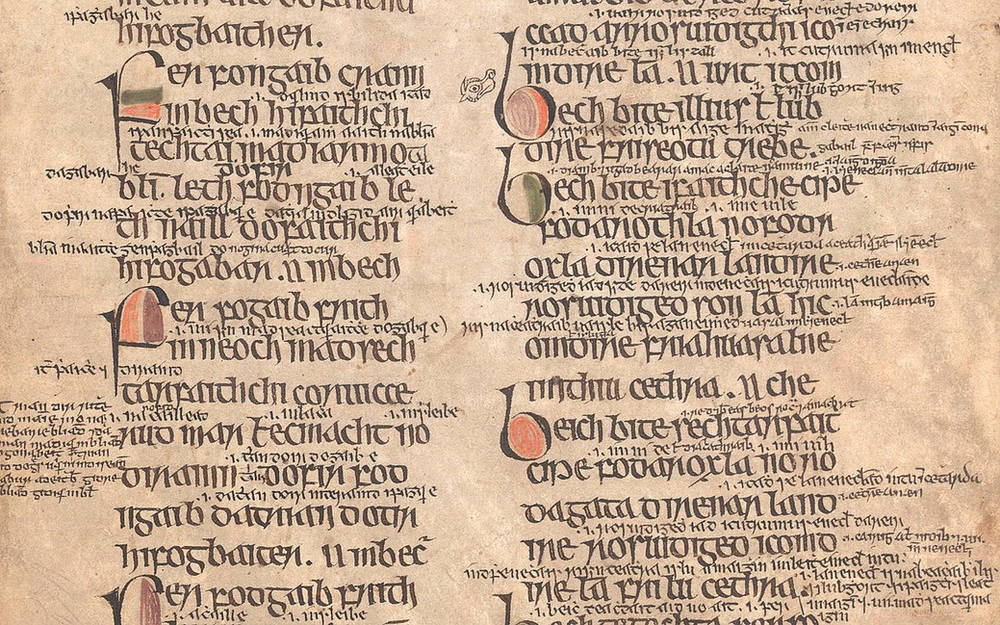
This month we will be celebrating the 850th anniversary of the marriage of Strongbow and Aoife which occurred in the aftermath of the Anglo-Norman Siege of Waterford in 1170. Their marriage changed Ireland forever and is possibly the most important marriage to have ever happened on this island – but did you know that the events which preceded the invasion of Strongbow’s forces had actually been set in motion eighteen years earlier?
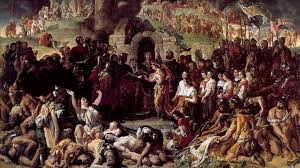
Most of us know that Diarmuid Mac Murchada, the King of Leinster and father of Aoife was deposed in 1166, but do you know why? Some sources believe that the catalyst for this invasion was in 1152 when a much younger Diarmuid abducted Derbforgaill (Sometimes spelled Derval) Iníon Maechleachlainn, wife of the King of Breifne, Tighearnán Mór Ua Ruairc. Diarmuid has gone down in history as ‘Diarmuid of the Foreigners’ but in life he was known to be ruthless and calculating – an ambitious man who made fortunes and took them away just as quickly, who would do virtually anything to further his own cause and expand his own kingdom. His ambition got him in trouble more than once but the events of 1152 almost ruined his fortunes forever and drove him abroad into the house of one Richard de Clare…
Gaelic Ireland was a competitive place to rule and Kings who had been allies one day could be mortal enemies locked in a bitter land dispute the next. Diarmuid Mac Murchada had shown himself early in his rule to be a ruthless war lord, and while at an earlier stage in his rule both he and Tighearnán Mór Ua Ruairc had worked together to mount raids on the kingdom of Munster as late as 1151, but by 1152 Diamuid had turned against him and joined with the High King, Tairdelbach Ua Conchobair to launch a raid into Breifne. It was during this raid that Mac Murchada stole Derbforgaill away along with her wealth and apparently on the advice of her brother.

The Annals of the Four Masters combined all the available accounts to come up with the fairest assessment of the events, stating:
An army was led by Mac Lochlainn into Meath, as far as Rath-Ceannaigh, to meet the men of Ireland; and Toirdhealbhach proceeded into Meath, to meet Ua Lochlainn and Diarmaid Mac Murchadha, King of Leinster. They divided Meath into two parts on this occasion; they gave from Cluain-Iraird westwards to Murchadh Ua Maeleachlainn, and East Meath to his son, Maeleachlainn. They took Conmhaicne from Tighearnan Ua Ruairc, after having defeated him; and they burned the town named Bun-cuilinn, and gave the chieftainship to the son of Gillabraide Ua Ruairc, and their hostages were given up to Toirdhealbhach Ua Conchobhair. On this occasion Dearbhforgaill, daughter of Murchadh Ua Maeleachlainn, and wife of Tighearnan Ua Ruairc, was brought away by the King of Leinster, i.e. Diarmaid, with her cattle and furniture; and he took with her according to the advice of her brother, Maeleachlainn. There arose then a war between the Ui-Briuin and the men of Meath.
There is some question over whether it truly was an abduction or if Derbforgaill went willingly with the King of Leinster. She was married to the King of Breifne, but her family may have desired a better match for her. Under Brehon Law women had a say in their marriage and had to explicitly agree to the wedding before it happened. Divorce was also relatively simple and women were allowed to walk away with the property they brought into the relationship. When Derbforgaill went with Diarmuid she went with her cattle and furniture, so it is possible that if it was not love that caused the abduction it could have been intentions of a new marriage between two noble families.The fact that she was taken on the advice of her brother certainly suggests that her family had their eyes on a better opportunity for Derbforgaill.

Contemporary sources do not allude to this, and the Annals of Tiggernach simply state that ‘Diarmaid mac Murchadh, king of Leinster, forcibly carried off out of Meath the wife of Ó Ruairc, that is, Derbhfhorgaill, daughter of Murchadh, with her wealth’. Later Annals are more judgmental of her character and both Irish and British sources put forward the ideas of lust and love and paint Derbforgaill as a fickle woman in search of a better marriage than she already had, or of a woman easily waylaid by her family. Thankfully for Derbforgaill, it seems she only had to endure capture for about a year with Diarmuid before she escaped in 1153 and returned to her husband. Whether there was romance involved or not, Tighearnán Mór Ua Ruairc was understandably annoyed, and kept a desire for revenge burning right up to 1166. In 1167, on top of the loss of his throne, Diarmuid was forced to pay him 100 ounces of gold by way of compensation.
Diarmuid would have the last laugh though – two years later he returned to Ireland with an army of Welsh archers at his back and by 1171 even Ua Ruairc was forced to submit to the foreign invaders – but all of that saga can wait until next week!
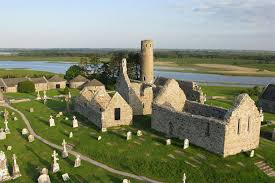
Derbforgaill herself is easy to view as a pawn in this whole situation, especially as we are not entirely sure of her own view of all of these events and she has become known as the ‘Helen of Ireland’ in reference to the events that happened at Troy. However she was a women in a culture which made some space for women’s lives, and has at least some element of control over her life. Unusually for a women of that age the events of her life are discussed in the Annals of Ireland no less than five times, from her abduction to her charitable work, her legacy, her retirement and her death. She may not be the face that launched 1,000 ships, but her abduction and its aftermath did arguably lead to a different invasion which changed the face of Ireland forever.
Check back next Tuesday for the next in our series on the Marriage of Strongbow and Aoife or book your place at our free re-enactment of Waterford’s most famous wedding happening in Cathedral Square on August 25th at 2PM! If you would like to book a place, please email Donnchadh at [email protected]
